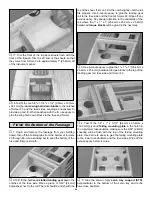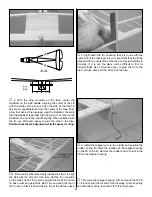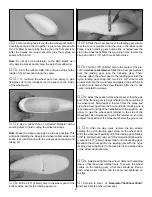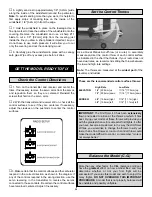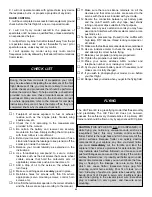
❏
6. Lightly sand a strip approximately 1/8" [3.2mm] wide
along the inside of the windshield (around the perimeter).
Note: To avoid sanding more than you want, it is helpful to
first apply strips of masking tape on the inside of the
windshield, 1/8" [3.2mm] in from the edge.
❏
7. Hold the windshield in place on the fuselage. Use a
fine tip marker to trace the outline of the windshield onto the
covering. Remove the windshield and use a sharp #11
blade to cut a 1/8" [3.2mm] strip from the covering just
inside the line you drew. A sharp blade is important, so you
do not have to use much pressure. It will allow you to cut
only the covering and not the underlying wood.
❏
8. Carefully glue the windshield in place with a canopy
safe glue. Wipe off any excess glue before it dries.
❏
1. Turn on the transmitter and receiver and center the
trims. If necessary, remove the servo arms from the servos
and reposition them so they are centered. Reinstall the
screws that hold on the servo arms.
❏
2. With the transmitter and receiver still on, check all the
control surfaces to see if they are centered. If necessary,
adjust the clevises on the pushrods to center the control
surfaces.
❏
3. Make certain that the control surfaces and the carburetor
respond in the correct direction as shown in the diagram. If
any of the controls respond in the wrong direction, use the
servo reversing in the transmitter to reverse the servos
connected to those controls. Be certain the control surfaces
have remained centered. Adjust if necessary.
Use a Great Planes AccuThrow (or a ruler) to accurately
measure and set the control throw of each control surface
as indicated in the chart that follows. If your radio does not
have dual rates, we recommend setting the throws between
the low and high rate settings.
Note: The throws are measured at the widest part of the
elevators and rudder.
More than any other factor, the C.G. (balance point) can
have the greatest effect on how a model flies, and may
determine whether or not your first flight will be
successful. If you value this model and wish to enjoy it for
many flights, DO NOT OVERLOOK THIS IMPORTANT
PROCEDURE. A model that is not properly balanced will
be unstable and possibly unflyable.
Balance the Model (C.G.)
IMPORTANT: The Old Timer 40 has been extensively
flown and tested to arrive at the throws at which it flies
best. Flying your model at these throws will provide you
with the greatest chance for successful first flights. If, after
you have become accustomed to the way the Old Timer
40 flies, you would like to change the throws to suit your
taste, that is fine. However, too much control throw could
make the model difficult to control, so remember, “more is
not always better.”
These are the recommended control surface throws:
High Rate
Low Rate
ELEVATOR:
7/8" [22.2mm] up
11/16" [17.5mm] up
7/8" [22.2mm] down
11/16" [17.5mm] down
RUDDER:
5/8" [15.9mm] right
7/16" [11.1m] right
5/8" [15.9mm] left
7/16" [11.1mm] left
Set the Control Throws
4-CHANNEL
TRANSMITTER
TRANSMITTER
4-CHANNEL
TRANSMITTER
4-CHANNEL
Check the Control Directions
GET THE MODEL READY TO FLY
39
Содержание Old Timer
Страница 6: ...6 DIE PATTERNS...
Страница 7: ...7 DIE PATTERNS...
Страница 44: ...TWO VIEW DRAWING Use copies of this page to plan your trim scheme...
Страница 45: ...B C...
Страница 46: ...D A...


